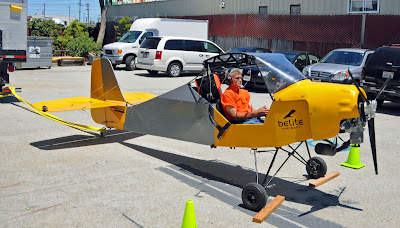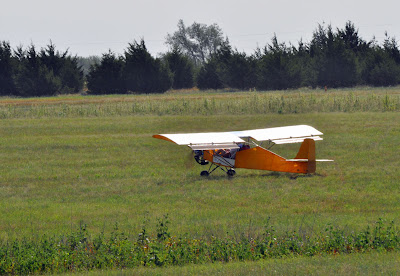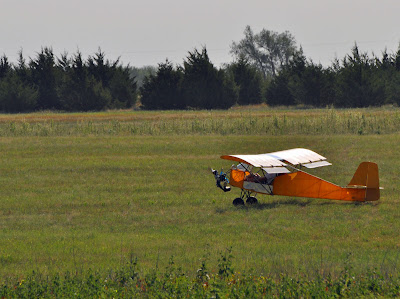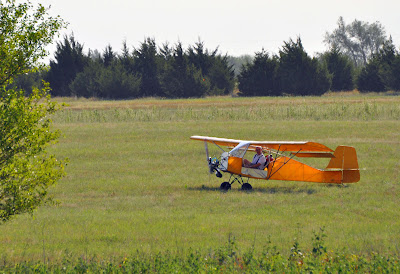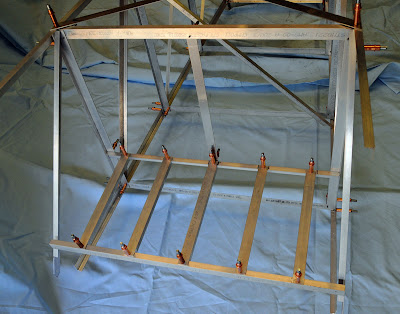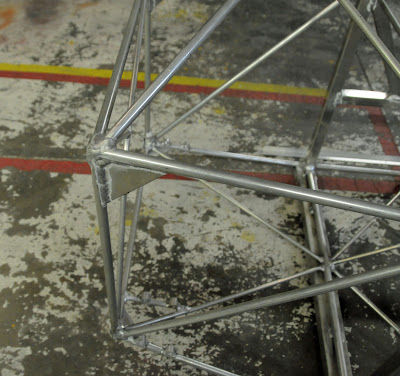Please note: James' blog has moved to a Wordpress site. To access it, please visit
http://jameswiebe.wordpress.com/. All posts have been transferred to the new site, and all new posts will only be accessible via Wordpress. Thank you for your interest!
The air temperature had settled to about 82 or 83 degrees. This felt
comfortable; especially in comparison to the brutal days of our earlier
summer. And after rolling down the grass runway and leaving the ground,
the air aloft was even gentler and cooler. And the air was calm.
I was catching a ride in an old friend, and it was a privilege to be a guest
in the airplane we've known as 'Harley':
 |
| Ultralight Aircraft from Belite Aircraft |
The takeoff roll was a little long; a lack of headwind was to blame.
Maybe some of my 200 pounds contributed to the longer roll as well. Even
so, I was able to join along for a comfortable rate of climb.
I noted that the pond off the far end of the runway is still very parched
for rain. A turtle slapped around in the shallows. I wonder if any
fish are living there. Also, I haven't seen any deer drinking there since
last fall. What will this fall bring? Harley wondered as well.
A tractor and bailer attachment were ignominiously parked in the middle of a
field nearby. The field offered a helpful place for an off-field landing,
should the need arise. But Harley didn't need it, never had.
The plane turned itself towards the North; I just followed along on the
controls. I was the guest. A row of cedar pines, very scruffy
looking, protected the eastern side of our gliderport, and I was able to greet
them and remind them of the presence of the orange and black airplane in which
I comfortably sat. With no wind on the ground, they didn't wave branches
to me, but we still saw each other, and we both knew of the special nature of
the flight.
The northern field had been plowed; I ignored the horse ranch to the
northeast of our field. The Harley knows that we don't like to fly low
and slow over the horse ranches; I remember the story of (some other)
ultralight flying over them and bucking a woman off a horse. The plane
and I respect the horses. If we choose to fly over them, we seek a
respectful altitude first.
A turn towards the runway, and then an overflight of a small group of people
who have assembled to take a tour of the Belite facility. Ostensibly, I
am flying as a demonstration for them, but really, Harley is flying as a
demonstration for me.
Then a nice turn over the people, and then Harley scoots for a low pass
besides some trees on the opposite side of the runway. Chasing rabbits --
imaginary, very large, very slow rabbits.
This plane was in our 'inventory' for about two years. I have no idea
why. It was (and is) beautiful. Nobody wanted it, because it wasn't
exactly what they wanted, or we wanted too much money, or something...
Except a few people did want it.
We sold this plane at least twice; one prospective owner changed his mind on
buying it after sending in the deposit money.
Harley was down-hearted after hearing that news -- pretty much like the dog
left perpetually out at night or the orphan rejected by potential parents, who
maybe smiled at the child in a meaningful way, yet lied in their heart at the
same time. Harley developed a sticking set of rings as a result, just
like people with emotional pain who develop physical ailments. My shop
manager, Gene, helped diagnose the ring problem and I happily ordered a new set
of rings and gaskets from the engine hospital. No big deal. Harley
was fixed.
One time, Harley had shown me how to do dead stick landings. I
remembered that very well, and you can see it again by
clicking
on this old post.
 |
| Deadstick landing in Ultralight Aircraft |
Harley also had suffered from a serious case of ugly cowl syndrome; we'd
flown him without a cowl (a long time ago) and also with an aluminum 'bib
cowl'. Although the bib cowl shined up nicely, Harley was always a little
embarrased with the bib cowl. He wanted to be with our other airplanes,
the ones with real fiberglass cowls and bumps where the pistons are supposed to
be.
I went through a box of his child photos. I found one of Harley with
his bib cowl.:
 |
| Utralight Aircraft with Aluminum Cowl |
Back then, he had carbon fiber struts (long removed); spring landing gear
(still work *awesome*); a full paint job; and a very nice basic panel. He
was long on good manners, both on the ground and in the air, and always managed
a smile.
I also found some photos of him playing in the sky:
 |
| Harley flying |
 |
| Utralight Aircraft in Right Turn |
|
|
But I'm still flying as Harley's guest.
I ask Harley if I can land, and he agrees.
We turn together toward our grass strip. I crank in one notch of
flaps, and reduce power. Harley comes in over fence. I add a second
notch of flaps, and reduce power further.
Harley is just over the grass, with nose just high, and a moment later the
wheels barely touch down. No bounce, no jostle. A moment later, we
pull toward the tour group, and the demo flight is over. Harley sat
proudly in the middle of a group of children and Big Brothers / Big Sisters of
Sedgwick county, and he helped me answer question after question about
ultralight aircraft and how we build them.
After helping Harley get back in the hangar for the night, I chocked one of
his wheels and headed over to the assembly room to see how Harley was built.
Harley was left with wings extended, sitting in a hangar with Cessna 182's,
gliders, and other Belite parts. He was very happy to be in the main
hangar, and he was important, just as important as the Cessna 182.
Even more important to a gentleman who wanted to fly Harley and help them
rediscover their mutual love for flying.
Tomorrow morning, Harley's new owner gets to sit in Harley for the first
time. He has arrived from the east coast to see and take ownership of
Harley.
Harley was sold for about $14,000. Harley was promotionally priced
because we wanted to reduce our inventory of steel fuselage airplanes as we
bring our larger and lighter aluminum fuselage production online.
BTW, Harley also has a new orange fiberglass cowl. The alumimum bib
skin is gone.
From our Facebook:
Fun
fact: Flying our Harley airplane will make you
feel rugged and fearless, just like the motorcycle it is named after.
That wasn't true. But this is true:
Fun
fact: Flying our Harley airplane will make you
feel that flying is one of the greatest gifts and privileges that God gave
us.
